Updated 01/09/2024 – The Black Labradoodle has a unique appeal, thanks to their captivating looks and endearing fluffy face. Their popularity among Labradoodle enthusiasts is well-deserved, but there’s much more to these striking dogs than meets the eye.
Let’s begin by exploring some interesting facts and considerations about the black Labradoodle that you may not know.
- First, did you know that there are two (2) kinds of Labradoodles: The Australian Labradoodle and the American Labradoodle. The difference between these two breeds include their breeding, cost and temperament.
- Secondly, their sleek black coat may undergo changes as they mature. Some black Labradoodles experience a fading or lightening of their coat, transitioning to shades of charcoal or silver.
- Furthermore, there is a perspective held by some that suggests a Labradoodle’s coat color might influence their personalities.
Join us as we take a look at the Black Labradoodle, uncovering unique traits and insights often overlooked by others.

Looking for a doodle with black fur? Check out our posts on other types of doodles can have black coats like the Bernedoodle, black Goldendoodle, Newfiepoo and mini Goldendoodle.
Types of Labradoodles
As I mentioned above, there are two types of Labradoodles: the Australian Labradoodle and the American Labradoodle. Although they both originated as cross-breeds, the Australian Labradoodle has a more extensive lineage and history.
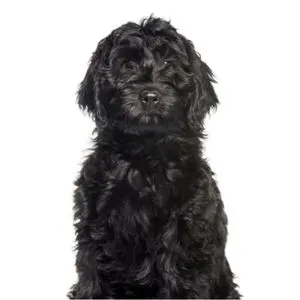
History of the Labradoodle
Labradoodles got their start in Australia when a woman in Hawaii reached out to the Royal Guide Dog Association of Australia. She was looking for a guide dog that would not trigger her husband’s allergies.
They first tried to train standard poodles to be guide dogs since they were known to be hypoallergenic. But after trialing 33 different standard poodles, it was determined that they did not have the right temperament for the job.
So the next idea was to breed the hypoallergenic, standard poodle to the hardworking and trainable Labrador Retriever. The hope was that the combination would result in at least one puppy that could work for the women and her husband.
Out of the 3 puppies that resulted from the pairing only one proved not to affect the husband’s allergies. This one pup went on to be trained as a guide dog for the woman.
But that left two dogs without a home to go to. It seemed no one wanted a mixed breed guide dog.
So to find them homes, the dogs were named Labradoodles and touted as a special new breed that was hypoallergenic. Since that time, the demand for the Labradoodle has exploded.
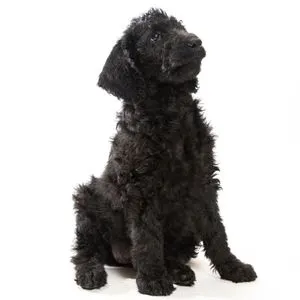
Australian Labradoodle
As demonstrated in the preceding story, the original Labradoodles in Australia were the result of a first-generation cross between a Labrador Retriever and a Standard Poodle.
However, modern-day Australian Labradoodles have evolved into a more intricate blend of several breeds. In the quest to develop the ideal companion animal, breeders conducted experiments by introducing spaniels into the breeding process. The primary aim was to consistently produce litters with specific traits in terms of appearance, coat texture, and temperament.
The contemporary Australian Labradoodle typically encompasses a genetic mix that includes, at a minimum, Poodle, Labrador Retriever, English Cocker Spaniel, and American Cocker Spaniel.
Additionally, a few other breeds were occasionally incorporated to a lesser degree in the development of the Australian Labradoodle, although they have largely been phased out over time. Nevertheless, the genetic influence of these other breeds may still be evident in the DNA profiles of some individual dogs.
American Labradoodle
The American Labradoodle is a classic crossbreed between a Poodle and a Labrador Retriever. However, there’s a bit of confusion around the name because some breeders refer to it as an Australian Labradoodle. This is due to the fact that the original Labradoodles originated in Australia.
Nevertheless, it’s important to note that they are not the same breed. The Australian Labradoodle is a multi-generation dog, while the American Labradoodle can be a true first-generation Labradoodle, often retaining much of the Labrador’s personality. Though you can also find later generation Labradoodles but they will not have spaniel in their ancestry.

The difference between the Australian Labradoodle and the American Labradoodle
As I hinted earlier, there are differences between the Australian and American Labradoodles. Here are a few of them.
One of the biggest differences is in their consistency:
- Australian Labradoodle: Australian Labradoodle breeders tend to follow a more standardized breeding program with specific goals for coat type, temperament, and health. This has led to a relatively consistent look and temperament within the breed over time.
- American Labradoodle: American Labradoodles can vary more in terms of appearance and temperament due to a less standardized breeding approach. This means there will be differences in sizes, coat types and personality based on the breeders preferences.
Personality can also differ between the two types of labradoodles
- Australian Labradoodles generally have a reputation for being friendly, highly trainable, and affectionate companions with moderate to high energy levels.
- American Labradoodles, on the other hand, can vary more in terms of personality due to their less standardized breeding history. Some may closely resemble Australian Labradoodles, while others may lean more towards the personalities of one or the other parent breeds.
All About the Black Labradoodle
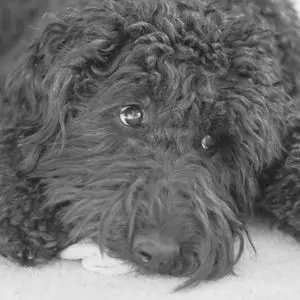
Labradoodle Sizes
You can find Black Labradoodles in all the same size ranges as the other colored Labradoodles which include standard, medium, miniature and micro mini.
The size of an American Labradoodle is typically influenced by the size of the poodle used in breeding and the generation classification, but the exact size may not be evident until they reach adulthood due to genetic variability.
This uncertainty is particularly pronounced in first-generation American Labradoodles when breeding dogs of different sizes. In contrast, multi-generation doodles like the F2b Labradoodle and the Australian Labradoodle tend to have fewer size-related discrepancies due to less genetic variability over time.
Size ranges for the Australian Labradoodle
- Petite or Micro Mini – Less than 14 inches in height
- Miniature – between 14 and 16 inches in height
- Medium range – between 17 and 20 inches in height
- Standard range – between 21 and 24 inches in height
The above size ranges are from the Australian Labradoodle Association of America. These size ranges are commonly used for the American Labraoodle too.
An American Labraoodle’s weight can vary based on which parent breed they take after. Labrador Retrievers tend to have a muscular, stocky build, where the poodle tends to have a leaner, athletic build.

Labradoodle Generations
As mentioned earlier, American Labradoodles are categorized into different generations, with common codes including F1, F1b, and F2. These generation codes provide insights into a dog’s breeding and genetic makeup.
For instance, an F1 Labradoodle is a 50% Poodle and 50% Labrador Retriever mix. When an F1 Labradoodle is bred with a Poodle, it results in an F1B Labradoodle, which is believed to have a reduced likelihood of shedding due to its higher Poodle genetics. In some cases, an F1B doodle can also be 25% Poodle and 75% Retriever if an F1 doodle is crossed with a Retriever.
These generation classifications were developed to estimate the amount of Poodle genes in a Labradoodle beyond the initial F1 generation. Since Poodles are known for being low-shedding and considered hypoallergenic, a higher percentage of Poodle genes indicates a lower likelihood of shedding in Labradoodles.
However, in multigenerational doodles like the F2 Labradoodle, the exact percentage of poodle or Lab that is passed down is really unknown.

Black Labradoodle Personality
Black Labradoodles typically exhibit friendly and affectionate personalities. They are known for their sociable nature and tend to be intelligent and eager to please. Their playful and active disposition means they enjoy physical activities and are often up for outdoor adventures. Labradoodles are also known for their love of water.
Does fur color affect personality?
You might have heard that certain coat colors in Labradors can influence their trainability. In a 2014 study published in the journal Applied Animal Behavior Science, findings appeared to support this notion.
This study set out to investigate whether Chocolate Labrador Retrievers presented more challenges in training and displayed higher levels of hyperactivity and aggression compared to the more prevalent black Labradors.
To do this, researchers gathered data from 1,978 dogs, which encompassed their behavioral patterns and details regarding their physical attributes and trainability from their owners.
The study’s results indicated that “Chocolate Labrador Retrievers were more ‘agitated when ignored’ and showed more ‘excitability’ than black dogs, and lower ‘trainability’ and ‘noise fear’ than both yellow and black dogs.”
The good news for anyone looking for a Black Labradoodle is that the study found that the black Labrador was considered the easiest to train and the most common choice for hunters.
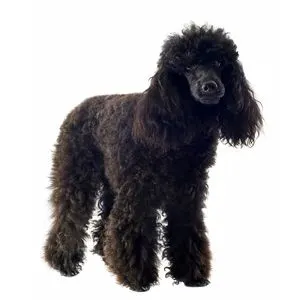
Training requirements of a Black Labradoodle
When it comes to training, you’ll find that they are generally quite easy to train. These dogs are known for their intelligence and eagerness to please, which makes the training process smoother.
Effective training methods typically involve positive reinforcement techniques. This means rewarding them with treats, praise, or affection when they exhibit desired behaviors. This positive approach helps motivate them to learn and repeat good behavior.
Consistency is crucial in training. Establish clear boundaries and rules from the beginning, and make sure all family members follow them consistently. This helps prevent confusion and reinforces the lessons you’re teaching. It will also lead to quicker potty training
Training your puppy should be done in short intervals throughout the day. Puppies, like children, have very short attention spans. They will only be able to concentrate for a few minutes at a time.
Socialization is another essential aspect of training for Labradoodles. It’s important to expose them to various people, animals, and environments from a young age. This helps them become well-adjusted and confident adults, reducing the chances of behavior problems later on.
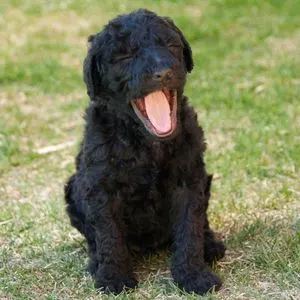
Not sure if you want a Labradoodle, Goldendoodle or Poodle? Check out our posts on Goldendoodle vs Labradoodle: Which is Better? and Standard Poodle vs Labradoodle: A Detailed Comparison.
Black Labradoodle’s Frequently Asked Questions
Are Black Labradoodles Rare?
Because black is a dominant color for Labradoodles, black Labradoodles are not rare. But be careful when selecting a breeder. They should have a good understanding of the genetics that go into Labradoodle colors or you could end up with a dog that is no longer black when they are full grown.

Do Black Labradoodles Shed?
One very common question about the Black labradoodle is whether a dog’s coat color influences the amount of shedding they experience. The answer to this question is no; there is no direct connection between the color of a dog’s fur and shedding.
Instead, shedding tendencies in Labradoodles and other dogs are primarily determined by specific genes, particularly the MC5R and RSPO2 genes. These genes play a crucial role in regulating the growth and shedding of fur. The combination of these genes in an individual Labradoodle will determine whether they shed a lot or just a minimal amount.
It’s important to understand that there is no such thing as a completely non-shedding dog. Some breeds, like Poodles, tend to shed less, but all dogs will naturally lose some hair over time.
To help potential Labradoodle owners predict shedding levels in their puppies, genetic tests for the MC5R and RSPO2 genes are available. Breeders can use these tests to assess the shedding potential of the parents.
Before genetic testing became common, breeders relied on visual cues, such as the type of fur, facial fur length, and generation classification (first generation vs. multi-generation), to make educated guesses about a Labradoodle’s shedding tendencies.

Black Labradoodle Fur Types
You can expect a variety of fur types with Labradoodles, which are influenced by their doodle generation. Fur types commonly found in Labradoodles include:
- Curly Coat: Some Labradoodles can have tightly curled or woolly coats, similar to the Poodle parent. This type of coat tends to be low-shedding. You will find this fur type is most common in later generation doodles. It is also the fur type that takes the most effort to maintain.
- Wavy Coat: Many Labradoodles have wavy coats that are a mix between curly and straight. These coats can range from loose waves to more defined waves. They typically require regular grooming but still tend to be lower shedding.
- Straight Coat: Some Labradoodles inherit a straighter coat, which resembles the Labrador Retriever parent’s coat. Straight-coated Labradoodles may shed more than those with curly or wavy coats.
- Fleece Coat: This is a soft and silky coat type that is often found in Labradoodles. It is wavy to loose-curl in appearance and is usually low-shedding.
It’s important to note that the coat type and shedding of a Labradoodle can vary even within the same litter, as they can inherit different coat genes from their parents.
Regular grooming is typically required to keep their coats healthy and free of matting, regardless of the specific fur type.
It is also possible for a dog to have an irregular cost. Meaning they can have two types of fur. Our mini doodle is like this.

Are Black Labradoodles Good Dogs?
Yes, Black Labradoodles can make excellent dogs due to their friendly and affectionate personalities. They are known for being great companions, whether for families or individuals. Their intelligence and eagerness to please make them relatively easy to train.
Plus their playful and energetic disposition can be a source of joy for active families and outdoor enthusiasts.
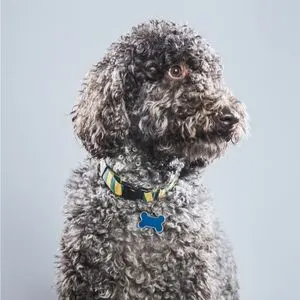
Can a Black Labradoodle Turn Silver?
It’s possible for your Labradoodle to inherit the G (progressive graying) locus from their poodle side. This gene affects dogs with black fur, causing their fur to turn silver over time. Dogs with the progressive graying gene will start off with a rich black coat color but it will lighten up overtime to a gray or silver color.
Are Black Labradoodles Hypoallergenic?
Black Labradoodles, like other Labradoodles, are often considered hypoallergenic to some extent. However, it’s crucial to understand that their hypoallergenic qualities can vary from one individual to another.
When we look back at the first Labradoodles bred in Australia in the story above, we see that not all of the puppies were hypoallergenic. In fact, only one out of the three puppies born from the initial breeding, did not trigger the husband’s allergies. This highlights a key point: not all Labradoodles are hypoallergenic.
The concept of hypoallergenic dogs is related to pet allergies, which are typically caused by proteins found in a dog’s skin cells, saliva, and urine. When a dog sheds, small pieces of skin (dander) become airborne, and this can potentially lead to allergic reactions in some people.
Labradoodles, are selectively bred to shed less, which can reduce the presence of allergenic dander in the air. However, shedding is just one way people can come into contact with the proteins. Everyday dog parent duties will expose you to the protein.

Are Black Labradoodle’s Healthy?
Because the American Labradoodle is a mix of two dog breeds, long term data on their health and lifespan is limited. Instead we need to look at the type of health conditions the parent breeds may have.
Below is a list of 10 common health problems for the Poodle and Labrador Retriever based on data from Metlife Pet Insurance.
10 Common Health Problems for the Poodle and Labrador Retriever
| Poodle | Labrador Retriever |
| Addison’s Disease | Obesity |
| Hip Dysplasia | Hip Dysplasia |
| Cushing’s Disease | Osteochondritis Dissecans – soft joints |
| Epilepsy | Eye Disease |
| Bloat | Epilepsy – seizures |
| Allergies – skin allergies | Allergies – environmental allergies |
| Cancer | Bloat |
| Blood Clotting Diseases | Tumors |
| Kidney Disease | Exercise-Induced Diseases |
| Cataracts – usually progress to blindness | Heart Disease |
Hybrid Vigor
Hybrid vigor is a term that breeders often use to describe Labradoodles. But hybrid vigor is associated with dogs that have several breeds in them. The argument is that the more genetically diverse a dog is, the less likely they will suffer from genetic health conditions.
Since the American Labradoodle only has two breeds that share some of the same health concerns, it is less likely that they will benefit from hybrid vigor. Also since multi-generation doodles are breed back to one or the other breed the benefits of hybrid vigor lessens.

Does a Black Labradoodle get hot in the sun?
All dogs will get hot if left out in the hot sun without a way to cool off, but a black Labradoodle will get hotter, faster than a light colored Labradoodle when left out in the sun. The darker the fur is, the more heat they draw in and retain.
How much is a Black Labradoodle?
Since the black Labradoodle is a common color and easier to breed they will not have a premium added to their final cost like some Labradoodles with rare colors or patterns.
The average price for a black Labradoodle is around $2,500 to $3,500 and the average price of a black Australian Labradoodle is around $ 3,500. You can find dogs for more or less depending on where you look and the size of the Labradoodle you are looking for.
Remember that a well-bred, genetically health tested Labradoodle will cost more than one from a puppy mill or backyard breeder, but it may save you in the long run.
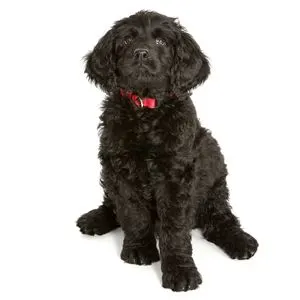
Where to find a Black Labradoodle to adopt?
Black Labradoodles are common in rescues. You can look for one in one of the many Labradoodle rescues we have listed.
Need a name for your new pup? Check out our dog name posts: Best Badass Black Dog Names for a Confident Pup and 499+ Best Black Dog Names, The Ultimate List of Ideas.
